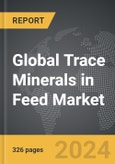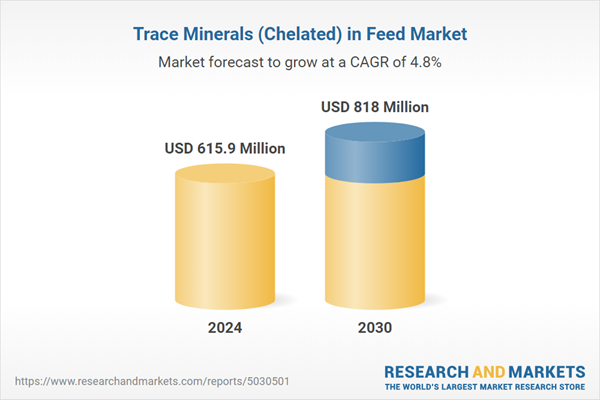The global market for Trace Minerals (Chelated) in Feed was valued at US$615.9 Million in 2024 and is projected to reach US$818.0 Million by 2030, growing at a CAGR of 4.8% from 2024 to 2030. This comprehensive report provides an in-depth analysis of market trends, drivers, and forecasts, helping you make informed business decisions. The report includes the most recent global tariff developments and how they impact the Trace Minerals (Chelated) in Feed market.
Segments: Type (Iron, Zinc, Manganese, Copper, Other Types); Livestock (Poultry, Swine, Ruminants, Aquaculture, Other Livestocks).
Geographic Regions/Countries: World; United States; Canada; Japan; China; Europe (France; Germany; Italy; United Kingdom; and Rest of Europe); Asia-Pacific; Rest of World.
The analysts continuously track trade developments worldwide, drawing insights from leading global economists and over 200 industry and policy institutions, including think tanks, trade organizations, and national economic advisory bodies. This intelligence is integrated into forecasting models to provide timely, data-driven analysis of emerging risks and opportunities.
Global Trace Minerals (Chelated) in Feed Market - Key Trends & Drivers Summarized
What Are Chelated Trace Minerals in Feed and Why Are They Important?
Chelated trace minerals in feed are essential nutrients bound to organic molecules, enhancing their stability and bioavailability for livestock. These minerals, including zinc, copper, iron, and manganese, play crucial roles in animal growth, immune function, and overall health. Chelation improves the absorption and utilization of these minerals compared to inorganic forms, leading to better animal performance and productivity. The importance of chelated trace minerals lies in their ability to address mineral deficiencies, improve feed efficiency, and support optimal animal health and welfare, making them a vital component of modern livestock nutrition.How Do Chelated Trace Minerals Function in Animal Nutrition?
Chelated trace minerals function by ensuring efficient delivery and absorption of essential nutrients in the animal’s digestive system. The chelation process involves binding minerals to amino acids or other organic molecules, protecting them from antagonistic interactions in the gut and enhancing their absorption. This improved bioavailability leads to better mineral uptake, supporting various physiological functions such as enzyme activation, bone development, and immune response. In practice, incorporating chelated trace minerals into animal feed results in improved growth rates, enhanced reproductive performance, and better overall health, reducing the need for medical interventions and promoting sustainable livestock production.What Are the Challenges and Opportunities in Chelated Trace Minerals Development?
The development and use of chelated trace minerals in animal feed present several challenges and opportunities. One major challenge is the higher cost of chelated minerals compared to inorganic forms, which can impact feed formulation budgets. Additionally, ensuring the stability and consistency of chelated minerals during feed processing and storage is crucial for maintaining their efficacy. On the opportunity side, the increasing focus on animal welfare and sustainable farming practices is driving demand for high-quality, bioavailable nutrients. Innovations in chelation technology and formulation are enhancing the stability and effectiveness of chelated minerals. Furthermore, growing awareness of the benefits of chelated minerals in improving animal health and productivity is encouraging their adoption in livestock nutrition programs.What Is Driving the Growth in the Chelated Trace Minerals in Feed Market?
The growth in the chelated trace minerals in feed market is driven by several factors. Firstly, the increasing demand for high-quality animal protein and dairy products is boosting the need for efficient and effective livestock nutrition. Secondly, the growing awareness of the benefits of chelated minerals in enhancing animal health and productivity is driving their adoption. Thirdly, advancements in chelation technology and formulation are improving the bioavailability and stability of these minerals, making them more attractive to feed manufacturers and livestock producers. Additionally, the rising focus on sustainable farming practices and animal welfare is encouraging the use of high-quality, bioavailable nutrients. Finally, supportive government regulations and initiatives promoting animal health and nutrition are further driving market growth.Report Scope
The report analyzes the Trace Minerals (Chelated) in Feed market, presented in terms of units. The analysis covers the key segments and geographic regions outlined below.Segments: Type (Iron, Zinc, Manganese, Copper, Other Types); Livestock (Poultry, Swine, Ruminants, Aquaculture, Other Livestocks).
Geographic Regions/Countries: World; United States; Canada; Japan; China; Europe (France; Germany; Italy; United Kingdom; and Rest of Europe); Asia-Pacific; Rest of World.
Key Insights:
- Market Growth: Understand the significant growth trajectory of the Iron segment, which is expected to reach US$347.1 Million by 2030 with a CAGR of a 4.8%. The Zinc segment is also set to grow at 5.7% CAGR over the analysis period.
- Regional Analysis: Gain insights into the U.S. market, valued at $166.5 Million in 2024, and China, forecasted to grow at an impressive 4.7% CAGR to reach $129.7 Million by 2030. Discover growth trends in other key regions, including Japan, Canada, Germany, and the Asia-Pacific.
Why You Should Buy This Report:
- Detailed Market Analysis: Access a thorough analysis of the Global Trace Minerals (Chelated) in Feed Market, covering all major geographic regions and market segments.
- Competitive Insights: Get an overview of the competitive landscape, including the market presence of major players across different geographies.
- Future Trends and Drivers: Understand the key trends and drivers shaping the future of the Global Trace Minerals (Chelated) in Feed Market.
- Actionable Insights: Benefit from actionable insights that can help you identify new revenue opportunities and make strategic business decisions.
Key Questions Answered:
- How is the Global Trace Minerals (Chelated) in Feed Market expected to evolve by 2030?
- What are the main drivers and restraints affecting the market?
- Which market segments will grow the most over the forecast period?
- How will market shares for different regions and segments change by 2030?
- Who are the leading players in the market, and what are their prospects?
Report Features:
- Comprehensive Market Data: Independent analysis of annual sales and market forecasts in US$ Million from 2024 to 2030.
- In-Depth Regional Analysis: Detailed insights into key markets, including the U.S., China, Japan, Canada, Europe, Asia-Pacific, Latin America, Middle East, and Africa.
- Company Profiles: Coverage of players such as Alltech, Archer Daniels Midland Company, BASF SE, Bluestar Adisseo Company Ltd., Cargill, Inc. and more.
- Complimentary Updates: Receive free report updates for one year to keep you informed of the latest market developments.
Some of the 48 companies featured in this Trace Minerals (Chelated) in Feed market report include:
- Alltech
- Archer Daniels Midland Company
- BASF SE
- Bluestar Adisseo Company Ltd.
- Cargill, Inc.
- DLG a.m.b.a
- Invivo
- Kemin Industries, Inc.
- Koninklijke DSM NV
- Novus International, Inc.
- Nutreco NV
- Phibro Animal Health Corporation
- Zinpro Corporation
Tariff Impact Analysis: Key Insights for 2025
Global tariff negotiations across 180+ countries are reshaping supply chains, costs, and competitiveness. This report reflects the latest developments as of April 2025 and incorporates forward-looking insights into the market outlook.The analysts continuously track trade developments worldwide, drawing insights from leading global economists and over 200 industry and policy institutions, including think tanks, trade organizations, and national economic advisory bodies. This intelligence is integrated into forecasting models to provide timely, data-driven analysis of emerging risks and opportunities.
What’s Included in This Edition:
- Tariff-adjusted market forecasts by region and segment
- Analysis of cost and supply chain implications by sourcing and trade exposure
- Strategic insights into geographic shifts
Buyers receive a free July 2025 update with:
- Finalized tariff impacts and new trade agreement effects
- Updated projections reflecting global sourcing and cost shifts
- Expanded country-specific coverage across the industry
Table of Contents
I. METHODOLOGYII. EXECUTIVE SUMMARY2. FOCUS ON SELECT PLAYERSIII. MARKET ANALYSISIV. COMPETITION
1. MARKET OVERVIEW
3. MARKET TRENDS & DRIVERS
4. GLOBAL MARKET PERSPECTIVE
UNITED STATES
CANADA
JAPAN
CHINA
EUROPE
FRANCE
GERMANY
ITALY
UNITED KINGDOM
REST OF EUROPE
ASIA-PACIFIC
REST OF WORLD
Companies Mentioned (Partial List)
A selection of companies mentioned in this report includes, but is not limited to:
- Alltech
- Archer Daniels Midland Company
- BASF SE
- Bluestar Adisseo Company Ltd.
- Cargill, Inc.
- DLG a.m.b.a
- Invivo
- Kemin Industries, Inc.
- Koninklijke DSM NV
- Novus International, Inc.
- Nutreco NV
- Phibro Animal Health Corporation
- Zinpro Corporation
Table Information
| Report Attribute | Details |
|---|---|
| No. of Pages | 195 |
| Published | April 2025 |
| Forecast Period | 2024 - 2030 |
| Estimated Market Value ( USD | $ 615.9 Million |
| Forecasted Market Value ( USD | $ 818 Million |
| Compound Annual Growth Rate | 4.8% |
| Regions Covered | Global |









